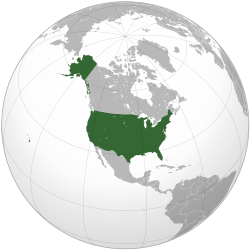
Back الأسلحة النووية والولايات المتحدة Arabic যুক্তরাষ্ট্রের পরমাণু অস্ত্র Bengali/Bangla Atomstreitkräfte der Vereinigten Staaten German Armas nucleares de Estados Unidos Spanish Arsenal nucléaire des États-Unis French נשק גרעיני בארצות הברית HE Amerykańska triada nuklearna Polish د متحده ایالاتو اټومي وسلې Pashto/Pushto Ядерный арсенал США Russian Ядерна зброя США Ukrainian
| United States | |
|---|---|
 | |
| Nuclear program start date | 21 October 1939 |
| First nuclear weapon test | 16 July 1945 |
| First thermonuclear weapon test | 1 November 1952 |
| Last nuclear test | 23 September 1992[1] |
| Largest yield test | 15 Mt (63 PJ) (1 March 1954) |
| Total tests | 1,054 detonations |
| Peak stockpile | 31,255 warheads (1967)[2] |
| Current stockpile | |
| Maximum missile range | ICBM: 15,000 km (9,321 mi) SLBM: 12,000 km (7,456 mi) |
| NPT party | Yes (1968) |
| Nuclear weapons |
|---|
 |
| Background |
| Nuclear-armed states |
|
The United States was the first country to manufacture nuclear weapons and is the only country to have used them in combat, with the bombings of Hiroshima and Nagasaki in World War II against Japan. Before and during the Cold War, it conducted 1,054 nuclear tests, and tested many long-range nuclear weapons delivery systems.[Note 1]
Between 1940 and 1996, the U.S. federal government spent at least US$11.7 trillion in present-day terms[6] on nuclear weapons, including platforms development (aircraft, rockets and facilities), command and control, maintenance, waste management and administrative costs.[7] It is estimated that the United States produced more than 70,000 nuclear warheads since 1945, more than all other nuclear weapon states combined.[8] Until November 1962, the vast majority of U.S. nuclear tests were above ground. After the 1963 Partial Nuclear Test Ban Treaty, all testing was relegated underground, in order to prevent the dispersion of nuclear fallout.[9] The United States has maintained a unilateral moratorium on nuclear explosive testing since 1992[10] and signed the Comprehensive Nuclear-Test-Ban Treaty in 1996. The Science-Based Stockpile Stewardship program shifted focus from continual weapon redesigns to understanding and limiting aging. Research continues via supercomputer simulation and nuclear physics experiments.[11]
By 1998, at least US$759 million had been paid to the Marshall Islanders in compensation for their exposure to U.S. nuclear testing.[12][13] By March 2021 over US$2.5 billion in compensation had been paid to U.S. citizens exposed to nuclear hazards as a result of the U.S. nuclear weapons program.[14]
In 2019, the U.S. and Russia possessed a comparable number of nuclear warheads; together, these two nations possess more than 90% of the world's nuclear weapons stockpile.[15][16] In 2025, it was estimated that the United States held 1,770 deployed warheads, 1,930 in reserve, and 1,477 retired and awaiting dismantlement, in total 5,177 nuclear warheads.[17] The projected costs for maintaining U.S. nuclear forces are $60 billion per year during the 2021–2030 period.[18]
- ^ "23 September 1992 – Last U.S. Nuclear Test". Testing Times. Preparatory Commission for the Comprehensive Nuclear-Test-Ban Treaty Organization. Retrieved 11 November 2017.
- ^ "Increasing Transparency in the U.S. Nuclear Weapons Stockpile" (PDF). Nuclear Posture Review (Fact Sheet). United States Department of Defense. 3 May 2010. Archived from the original (PDF) on 28 May 2010.
- ^ "United States nuclear weapons, 2025". Bulletin of the Atomic Scientists. 13 January 2025.
- ^ "United States nuclear weapons, 2025". Bulletin of the Atomic Scientists. 13 January 2025.
- ^ "Gallery of U.S. Nuclear Tests". The Nuclear Weapon Archive. 6 August 2001.
- ^ 1634–1699: McCusker, J. J. (1997). How Much Is That in Real Money? A Historical Price Index for Use as a Deflator of Money Values in the Economy of the United States: Addenda et Corrigenda (PDF). American Antiquarian Society. 1700–1799: McCusker, J. J. (1992). How Much Is That in Real Money? A Historical Price Index for Use as a Deflator of Money Values in the Economy of the United States (PDF). American Antiquarian Society. 1800–present: Federal Reserve Bank of Minneapolis. "Consumer Price Index (estimate) 1800–". Retrieved 29 February 2024.
- ^ "Estimated Minimum Incurred Costs of U.S. Nuclear Weapons Programs, 1940–1996". Brookings Institution. Archived from the original on 4 October 2013. Retrieved 18 August 2013.
- ^ Paine, Christopher E.; Cochran, Thomas B.; Norris, Robert S. (4 January 1996). "The Arsenals of the Nuclear Weapons Powers: An Overview" (PDF). Natural Resources Defense Council. Archived from the original (PDF) on 3 March 2016. Retrieved 22 July 2013.
- ^ Gross, Daniel A. (2016). "An Aging Army". Distillations. 2 (1): 26–36. Retrieved 28 March 2022.
- ^ U.S. Nuclear Weapons Tests, Congressional Research Service, January 23, 2025
- ^ Masco, Joseph (2004). "Nuclear technoaesthetics: Sensory politics from trinity to the virtual bomb in Los Alamos". American Ethnologist. 31 (3): 349–373. doi:10.1525/ae.2004.31.3.349. ISSN 1548-1425.
- ^ Cite error: The named reference
Brookingswas invoked but never defined (see the help page). - ^ "Radiation Exposure Compensation System Claims to Date Summary of Claims Received by 08/15/2013 All Claims" (PDF). United States Department of Justice. 16 August 2013. – updated regularly
- ^ Montoya Bryan, Susan (20 April 2021). "People downwind of atomic blasts renew push for US payout". AP NEWS. Retrieved 17 August 2021.
- ^ Reichmann, Kelsey (16 June 2019). "Here's how many nuclear warheads exist, and which countries own them". Defense News. Retrieved 16 April 2021.
- ^ "Global Nuclear Arsenal Declines, But Future Cuts Uncertain Amid U.S.-Russia Tensions". Radio Free Europe/Radio Liberty. 17 June 2019.
- ^ "United States nuclear weapons, 2025". Bulletin of the Atomic Scientists.
- ^ "Projected Costs of U.S. Nuclear Forces, 2021 to 2030". Congressional Budget Office. 24 May 2021.
Cite error: There are <ref group=Note> tags on this page, but the references will not show without a {{reflist|group=Note}} template (see the help page).
© MMXXIII Rich X Search. We shall prevail. All rights reserved. Rich X Search